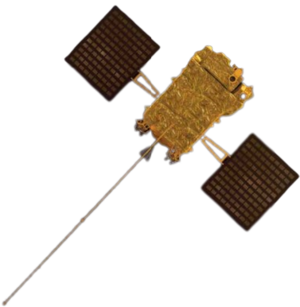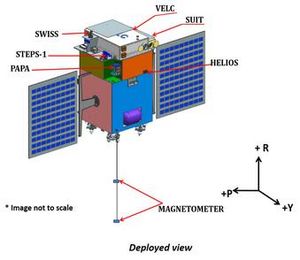Aditya-L1 facts for kids

Aditya-L1 in deployed configuration
|
|
| Mission type | Solar observation |
|---|---|
| Operator | ISRO |
| Mission duration | 5.2 years (planned) 1 year, 7 months and 14 days (elapsed) |
| Spacecraft properties | |
| Bus | I-1K |
| Manufacturer | ISRO / IUCAA / IIA |
| Launch mass | 1,475 kg (3,252 lb) |
| Payload mass | 244 kg (538 lb) |
| Start of mission | |
| Launch date | 2 September 2023, 11:50 IST (06:20 UTC) |
| Rocket | PSLV-XL |
| Launch site | Satish Dhawan Space Centre |
| Contractor | ISRO |
| Orbital parameters | |
| Reference system | Sun–Earth L1 |
| Regime | Halo orbit |
| Period | 177.86 days |
Aditya-L1 is a coronagraphy spacecraft to study the solar atmosphere, designed and developed by the Indian Space Research Organisation (ISRO) and various other Indian research institutes. It will be inserted at about 1.5 million km from Earth in a halo orbit around the L1 Lagrange point between the Earth and the Sun where it will study the solar atmosphere, solar magnetic storms, and their impact on the environment around Earth.
It is the first Indian mission dedicated to observing the Sun and was launched aboard a PSLV-XL launch vehicle at 06:20 UTC on September 2, 2023. It was launched ten days after the successful landing of ISRO's moon mission, Chandrayaan 3. It successfully achieved its intended orbit nearly an hour later. It was seperated from the fourth stage soon after at about 07:24 UTC.
Contents
Mission objectives
The major science objectives of the Aditya L1 mission are:
- Study of Solar upper atmospheric (chromosphere and corona) dynamics
- Study of chromospheric and coronal heating, physics of the partially ionised plasma, initiation of the coronal mass ejections, and flares
- Observe the in-situ particle and plasma environment, providing data for the study of particle dynamics from the Sun.
- Physics of the solar corona and its heating mechanism
- Diagnostics of the coronal and coronal loop plasma: Temperature, velocity and density.
- Development, dynamics, and origin of CMEs
- Identify the sequence of processes that occur at multiple layers (chromosphere, base, and extended corona) that eventually leads to solar eruptive events.
- Magnetic field topology and magnetic field measurements in the solar corona .
- Drivers for space weather (origin, composition and dynamics of solar wind .NM
History
Aditya was conceptualised in January 2008 by the Advisory Committee for Space Research. It was initially envisaged as a small 400 kg (880 lb), LEO(800 km) satellite with a coronagraph to study the solar corona. An experimental budget of 3 Crore INR was allocated for the financial year 2016–2017. The scope of the mission has since been expanded and it is now planned to be a comprehensive solar and space environment observatory to be placed at Lagrange point L1, so the mission was renamed "Aditya-L1". As of July 2019[update], the mission has an allocated cost of ₹785.3 million excluding launch costs.
Name
"Aditya" is derived from Surya, the revered Hindu deity representing the Sun. The "L1" designation denotes Lagrange point 1, signifying the precise location situated between the Sun and Earth where the Indian spacecraft is set to embark.
Overview

The Aditya-L1 mission will take around 109 Earth days after launch to reach the halo orbit around the L1 point, which is about 1,500,000 km (930,000 mi) from Earth. The spacecraft will remain in the halo orbit for its planned mission duration while maintained at a stationkeeping cost of 0.2 – 4 m/s per year. The 1,500 kg (3,300 lb) satellite carries seven science payloads with diverse objectives, including but not limited to, the coronal heating, solar wind acceleration, coronal magnetometry, origin and monitoring of near-UV solar radiation (which drives Earth's upper atmospheric dynamics and global climate), coupling of the solar photosphere to chromosphere and corona, in-situ characterisations of the space environment around Earth by measuring energetic particle fluxes and magnetic fields of the solar wind and solar magnetic storms that have adverse effects on space and ground-based technologies.
Aditya-L1 will be able to provide observations of Sun's photosphere, chromosphere and corona. In addition, an instrument will study the solar energetic particles' flux reaching the L1 orbit, while a magnetometer payload will measure the variation in magnetic field strength at the halo orbit around L1. These payloads have to be placed outside the interference from the Earth's magnetic field and hence could not have been useful in the low Earth orbit as proposed on the original Aditya mission concept.
One of the major unsolved issues in the field of solar physics is that the upper atmosphere of the Sun is 1,000,000 K (1,000,000 °C; 1,800,000 °F) hot whereas the lower atmosphere is just 6,000 K (5,730 °C; 10,340 °F). In addition, it is not understood how exactly the Sun's radiation affects the dynamics of the Earth's atmosphere on shorter as well as on longer time scale. The mission will obtain near simultaneous images of the different layers of the Sun's atmosphere, which reveal the ways in which the energy may be channeled and transferred from one layer to another. Thus the Aditya-L1 mission will enable a comprehensive understanding of the dynamical processes of the Sun and address some of the outstanding problems in solar physics and heliophysics.
Payloads
The instruments of Aditya-L1 are tuned to observe the solar atmosphere mainly the chromosphere and corona. In-situ instruments will observe the local environment at L1. There are total seven payloads on-board with four of them carrying out remote sensing of the Sun and three of them carrying in-situ observation.
Payloads along with their major capability of scientific investigation.
| TYPE | Sl.No | Payload | Capability |
|---|---|---|---|
| Remote Sensing Payloads | 1 | Visible Emission Line Coronagraph
(VELC) |
Corona/Imaging & Spectroscopy |
| 2 | Solar Ultraviolet Imaging Telescope (SUIT) | Photosphere and Chromosphere Imaging- Narrow & Broadband | |
| 3 | Solar Low Energy X-ray Spectrometer (SoLEXS) | Soft X-ray spectrometer: Sun-as-a-star observation | |
| 4 | High Energy L1 Orbiting X-ray Spectrometer(HEL1OS) | Hard X-ray spectrometer: Sun-as-a-star observation | |
| In-situ Payloads | 5 | Aditya Solar wind Particle Experiment(ASPEX) | Solar wind/Particle Analyzer Protons & Heavier Ions with directions |
| 6 | Plasma Analyser Package For Aditya (PAPA) | Solar wind/Particle Analyzer Electrons & Heavier Ions with directions | |
| 7 | Advanced Tri-axial High Resolution Digital Magnetometers | In-situ magnetic field (Bx, By and Bz). |
Development of payloads installed in Aditya L1
The science payloads of Aditya-L1 have been developed by different Indian laboratories in the country. All the payloads are developed with the close collaboration of various centres of ISRO.
| Sl.No | Payload | Laboratories |
|---|---|---|
| 1 | Visible Emission Line Coronagraph
(VELC) |
Indian Institute of Astrophysics, Bangalore |
| 2 | Solar Ultraviolet Imaging Telescope (SUIT) | Inter University Centre for Astronomy & Astrophysics , Pune |
| 3 | Aditya Solar wind Particle Experiment(ASPEX) | Physical Research Laboratory, Ahmedabad |
| 4 | Plasma Analyser Package For Aditya (PAPA) | Space Physics Laboratory, Vikram Sarabhai Space Centre, Thiruvananthapuram |
| 5 | Solar Low Energy X-ray Spectrometer (SoLEXS)
High Energy L1 Orbiting X-ray Spectrometer(HEL1OS) |
U R Rao Satellite Centre, Bangalore |
| 6 | Advanced Tri-axial High Resolution Digital Magnetometers | Laboratory for Electro Optics Systems, Bangalore |
Significance and potential discoveries
The Aditya-L1 mission holds the promise of significantly advancing our understanding of the Sun's behavior and its interactions with Earth and the space environment. The planned observations and data collection from this mission could lead to several groundbreaking discoveries and insights in the field of solar and heliophysics:
- Coronal Heating Mechanism: One of the central puzzles in solar physics is the coronal heating problem - why the Sun's corona is much hotter than its surface. Aditya-L1's instruments, particularly the Solar Ultraviolet Imaging Telescope (SUIT) and the Visible Emission Line Coronagraph (VELC), will enable detailed studies of the corona's dynamics and composition. By closely examining the behavior of the corona, scientists hope to unravel the mechanisms responsible for heating this outer layer of the Sun.
- Space Weather Prediction: Understanding the Sun's behavior is crucial for predicting space weather events, which can have significant impacts on Earth's technology and infrastructure. The mission's data will provide insights into the processes that lead to solar flares, coronal mass ejections (CMEs), and solar energetic particle (SEP) events. These insights can contribute to more accurate forecasting of space weather phenomena and their potential effects on communication systems, satellites, and power grids.
- Solar Wind and Magnetic Field Studies: Aditya-L1's instruments like the Aditya Solar wind Particle Experiment (ASPEX) and the Magnetometer will offer a comprehensive view of the solar wind's properties and the interplanetary magnetic field. This data will help refine models of the solar wind's behavior and its interaction with Earth's magnetosphere, shedding light on the dynamics of this critical space environment.
- Understanding Earth's Climate: The Sun's activity can influence Earth's climate over long timescales. Aditya-L1's observations of near-UV solar radiation and its impact on Earth's upper atmosphere can contribute to understanding how solar variability might affect Earth's climate patterns. This could provide valuable information for climate researchers seeking to differentiate between natural and anthropogenic factors driving climate change.
- Comprehensive Solar Atmosphere Imaging: The suite of instruments on Aditya-L1 will provide multi-wavelength observations of the Sun's atmosphere, from the photosphere to the corona. These simultaneous observations will allow scientists to trace the flow of energy and matter between different layers, offering insights into the complex processes that govern the Sun's behavior.
- Origin and Dynamics of CMEs: Coronal mass ejections are powerful and potentially disruptive solar events. Aditya-L1's observations of the initiation and evolution of CMEs will contribute to our understanding of their origins and behavior, potentially leading to improved models for predicting their occurrence and effects.
Launch
The launch of Aditya L1 mission took place successfully on September 2, at 11:50 a.m. IST. The Spacecraft was injected into the intended orbit at about 12:54 p.m. IST.
The first earth bound burn is planned to take place on September 3, at around 11:45 IST.
See also
 In Spanish: Aditya-L1 para niños
In Spanish: Aditya-L1 para niños
- Solar space missions
- Solar Orbiter
- Parker Solar Probe



